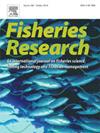Reproductive characteristics and spawning potential ratio modeling of a vulnerable riverine specialist in the lower unchannelized Missouri river, USA
IF 2.2
2区 农林科学
Q2 FISHERIES
引用次数: 0
Abstract
Reproductive characteristics for populations of imperiled, non-game species are not regularly studied but may be important for identifying factors associated with their population sustainability. Understanding reproductive traits of vulnerable species, particularly long-lived species, may provide insight for implementing management actions to respond to potential overharvest. This study aimed to assess the reproductive characteristics of a stable population of long-lived blue suckers (Cycleptus elongatus) in the unchannelized Missouri River in South Dakota. We obtained demographic information and gonads from 182 blue suckers collected in trammel nets in March 2021 and 2022. We used Bayesian generalized linear mixed-effects models to assess length and weight relationships with gonadosomatic index (GSI) and fecundity and used spawning potential ratios to model the influence of four minimum length limit scenarios. Total lengths of sampled fish ranged from 560 to 821 mm. Female GSI increased with length to ∼730 mm before declining, and male GSI remained consistent across lengths. Fecundity increased linearly with weight and with length to around 750 mm, after which the rate of increase slowed. Using a recent natural mortality estimate for this population, the spawning potential ratio under current no-limit regulations decreased rapidly as fishing mortality approached 0.10 but implementing a minimum length limit (e.g. 610- or 660 mm) could prevent the spawning potential ratio from falling below acceptable limits (0.2–0.3) at moderate-to-high fishing mortality values. This study provides necessary information about the reproductive characteristics of vulnerable, non-game species and demonstrates how spawning potential ratio modeling can be used for species that receive less management focus.
美国密苏里河下游未渠化的脆弱河流专家的生殖特征和产卵潜力比例建模
濒危非狩猎物种种群的生殖特征没有得到定期研究,但对于确定与其种群可持续性相关的因素可能很重要。了解脆弱物种,特别是长寿物种的生殖特征,可以为实施管理行动以应对潜在的过度捕捞提供见解。本研究旨在评估南达科塔州未开化的密苏里河中稳定种群的长寿命蓝吸盘(Cycleptus elongatus)的生殖特征。研究人员分别于2021年3月和2022年3月采集了182只蓝吸盘的人口统计信息和性腺。我们使用贝叶斯广义线性混合效应模型来评估长度和体重与性腺指数(GSI)和繁殖力的关系,并使用产卵潜力比来模拟四种最小长度限制情景的影响。取样鱼的总长度为560至821 毫米。雌性GSI随长度增加至~ 730 mm,然后下降,而雄性GSI在不同长度之间保持一致。繁殖力随体重和长度呈线性增加,增加到750 mm左右,之后增加速度减慢。根据最近对该种群的自然死亡率估计,在目前的无限制条例下,随着捕捞死亡率接近0.10,产卵潜力比迅速下降,但实施最小长度限制(例如610-或660 毫米)可以防止产卵潜力比在中等至高捕捞死亡率值降至可接受限度(0.2-0.3)以下。这项研究提供了关于脆弱的非狩猎物种的生殖特征的必要信息,并展示了如何将产卵潜力比例模型用于管理较少的物种。
本文章由计算机程序翻译,如有差异,请以英文原文为准。
求助全文
约1分钟内获得全文
求助全文
来源期刊

Fisheries Research
农林科学-渔业
CiteScore
4.50
自引率
16.70%
发文量
294
审稿时长
15 weeks
期刊介绍:
This journal provides an international forum for the publication of papers in the areas of fisheries science, fishing technology, fisheries management and relevant socio-economics. The scope covers fisheries in salt, brackish and freshwater systems, and all aspects of associated ecology, environmental aspects of fisheries, and economics. Both theoretical and practical papers are acceptable, including laboratory and field experimental studies relevant to fisheries. Papers on the conservation of exploitable living resources are welcome. Review and Viewpoint articles are also published. As the specified areas inevitably impinge on and interrelate with each other, the approach of the journal is multidisciplinary, and authors are encouraged to emphasise the relevance of their own work to that of other disciplines. The journal is intended for fisheries scientists, biological oceanographers, gear technologists, economists, managers, administrators, policy makers and legislators.
 求助内容:
求助内容: 应助结果提醒方式:
应助结果提醒方式:


